There has been a lot of talk about lease extensions in recent months from just about every corner of the industry in reaction to supply chain/reliability problems. Anecdotal levels of 70-100% are not uncommon. The overall trend is nothing new and was one of the key points I raised that would influence the market at our Dublin Breakfast Briefing back in January during the Airline Economics conference. Since then, I have dedicated a significant amount of time to digging further into this situation given the difficulty in tracking extensions as and when they occur. More recently, I presented an initial overview of the situation at the Shannon International Leasing Conference (SILC) in Limerick and judging by the questions raised in the following weeks, I thought it would be worthwhile raising here and covering additional factors not already discussed.
For those not in the know, a lease extension is an arrangement where a normal operating lease term can be extended from the initial termination date, postponing the transition back to the lessor. Extensions have been around since the advent of leasing when terms were often much shorter than we find today and motivated by operators who need to retain lift as an alternative to getting another aircraft from a different source. Some leases have preset extension terms already built into the initial lease, whilst the rest are negotiated before return discussions get underway. There are advantages and disadvantages to both transitions and extensions and generally, the market conditions at the time will normally dictate which way it will go. Similarly, there are key trends amongst certain lessees that influence it too. In all, there are around 20 good reasons (equally balanced) that tend to appear time and time again.
To benefit transitions, we would tend to see a mix of high fuel costs hurting old tech aircraft, demand for younger fleet, the need to negotiate better terms (lessor or lessee driven), lessee wanting to switch to a different aircraft type altogether, the lessor has another need for the aircraft, or new aircraft are on the way. Right now, high fuel costs and the need to negotiate much better terms (for the lessor) are the principal drivers for transitions.
To benefit extensions, the drivers tend to include, low lessee cash levels preventing return conditions from being met, lessees needing a payment holiday, OEM supply being constrained, new aircraft pricing rising, poor reliability with the replacement technology, transition costs/downtime avoidance, MRO supply constrained, or airlines have no clear replacement direction selected. Right now, just about everything is in play!
From both sides, there are generally more aspects in favour of extension than transition as it delays the high costs and uncertainty relating to maintenance, downtime, and remarketing. Consequently, it is not unusual to see narrowbody extensions sitting marginally above 50% (extensions ‘v’ transitions) over the past 25 years. As such, it is typical to see extension lease rates being set below transition lease rates. The typical terms are also normally just 1-2 years agreed ~1 year ahead. That’s for a normal market though!
We are clearly not in a normal market! Demand is up, backlogs and delivery lead times are way beyond historical levels, the reliability of the previous technology is vastly superior, and higher fares can offset higher fuel/staff costs (for the time being). Of course, this is not a new phenomenon, as previous downturns and supply constraints have triggered prior trends, however, the combination of drivers we face today far exceeds that seen previously. Not surprising when I estimate that the travel system will be missing >4,200 aircraft that will never be made through lost production over the eight years since the MAX grounding. Almost double the number I have seen estimated by others.
To illustrate this dynamic, I have compiled the mature lease activity for the A320ceo (as a proxy) from 2000 to today and projected out to 2030.
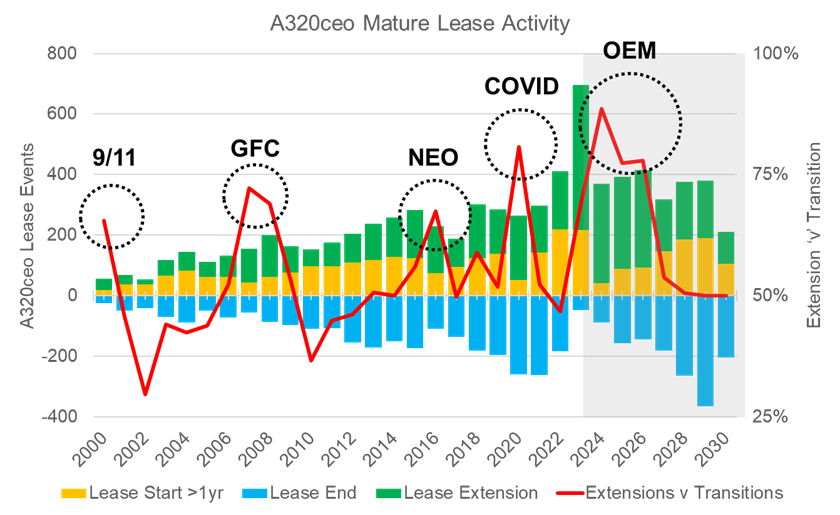
Source: IBA Insight & Intelligence
From the chart, we can see the spikes of extension demand triggered by poor lessee cash flow (9/11, GFC, and Covid-19 pandemic), supply constraints coupled with slow re-fleet decisions (NEO), and supply constraints (OEM). Similarly, we can see how levels fall once demand has been met, and how the baseline grows towards 50% as the fleet matures and lessor ownership widens. It is important to note that we see a similar trend for the 737-800, except worse as it started earlier and has freight demand to contend with. Similarly, the same trend is seen for widebodies like the 777-300ER and A330ceos, although they continue to occur at a lower level than the narrowbodies.
What makes the current spike so different from the prior ones is how the terms have changed. Whilst it is normal for 1–2-year extensions set a year ahead, we are now seeing terms grow to 4-6 years with deals being set for leases not expected to end as far out as 2026. Coupled with that, lease rates in some cases have risen >40% above the ages-specific rates negotiated just prior to the spike. Essentially, this means that in some extreme cases, aircraft that were due to return at year 12 are not expected to return until 2032 when they are 18 years old. More generally, it also means that mid-life A320 lease rates have shifted from the mid-100s to above 200. If airlines aren’t willing to go that far, then lessors are quite happy to get the aircraft back and re-lease elsewhere. What it goes to show is just how skewed the balance really is when demand recovery strikes.
I’m of the firm belief that the fallout from this doesn’t end there. If terms are lengthening and rates are improving (significantly), then surely these leases are worth more, provided credit quality doesn’t diminish too much. Whilst we correctly predicted that trading would be down this year, I’m more upbeat about 2024-2025. Supply still won’t be back to full strength, however, the demand for sale-leasebacks for those that do deliver will improve and be funded by the higher number of lessor sales with leases attached that should occur given the higher achievable pricing. Leases signed in the low-interest, high-supply environment, allow for a rebalance of expected returns and perhaps the trigger the market needs to attract new equity into the space. We’ve seen lessor consolidation, but that can be quickly undone with some sizeable portfolio sales to new entrants. Perhaps even the re-invigoration of the ABS market too!
So how long does this go on for? Ultimately no change until we reach a balance of predictable and reliable new technology deliveries against falling demand and interest rates. Aside from a sudden demand reset, not until 2027. With delivery lead times >7.5 years for A320neos and more stacking up, it could go out further.
There remains an element of caution though. Kicking the can down the road does potentially build a lease-end bubble further out. However, given the average age of the fleet will be quite high when the lease end spike hits, it might finally mean we get some real part-out activity to liberate the engines and parts the industry so desperately needs. Despite the huge commitment by the lessees to extend leases, I still don’t think they’ve fully thought through where they expect to get the engines from to keep them all flying. Surely this will mean the demand for shop visits will kick in just when the market expects to bank the cash! I expect engine lessors won’t have much left either!
We’re once again in the running for 'Appraiser of the Year' at the upcoming Airline Economics Aviation 100 Global Leaders Awards – but we need your help to secure the title!
Click the link below to vote for IBA on Question 18. Votes close on Wednesday, 20th December 2023.
Soon after the Dubai Airshow came to an end, Airbus announced a new order for 60 A320neo family aircraft from Japan-based SMBC Aviation Capital – the world’s second-largest lessor by in-service fleet size. This order follows a September one for 25 737 MAX and will bring SMBC’s already sizeable backlog of A320neo family to 183 aircraft, which places it at the top among all leasing companies.
As of November 2023, SMBC has a fleet of 570 aircraft in-service and 264 on order. Narrowbodies make up the bulk of the fleet – staggering 92% – with 337 being of the A320 family and 190 of the Boeing 737 family. With SMBC’s competitors actively growing their own backlogs and order-to-in-service ratios higher than ever, the decision to increase the order book makes perfect sense. The delivery issues experienced by Boeing and Airbus are not expected to be over soon, which makes the lessors anticipate even greater demand for new aircraft, especially the A320neo and A321neo.
The A320neo aircraft family is particularly popular, capturing a 60% market share and with a backlog reaching over 6,700 aircraft as of November 2023, according to IBA Insight. The lessors put in over 1,000 of those orders. The aircraft’s popularity in the lessor market can be attributed in part to its fuel efficiency, which makes it a very attractive choice for airlines. This in turn drives up the demand and the waiting time, which is now around 7.5 years. Both the orders’ pace and lessor demand do not show any signs of slowing down, with backlogs and waiting times reaching historic highs. The demand-supply imbalance continues and is allowing the lease rates on the aircraft to remain elevated.
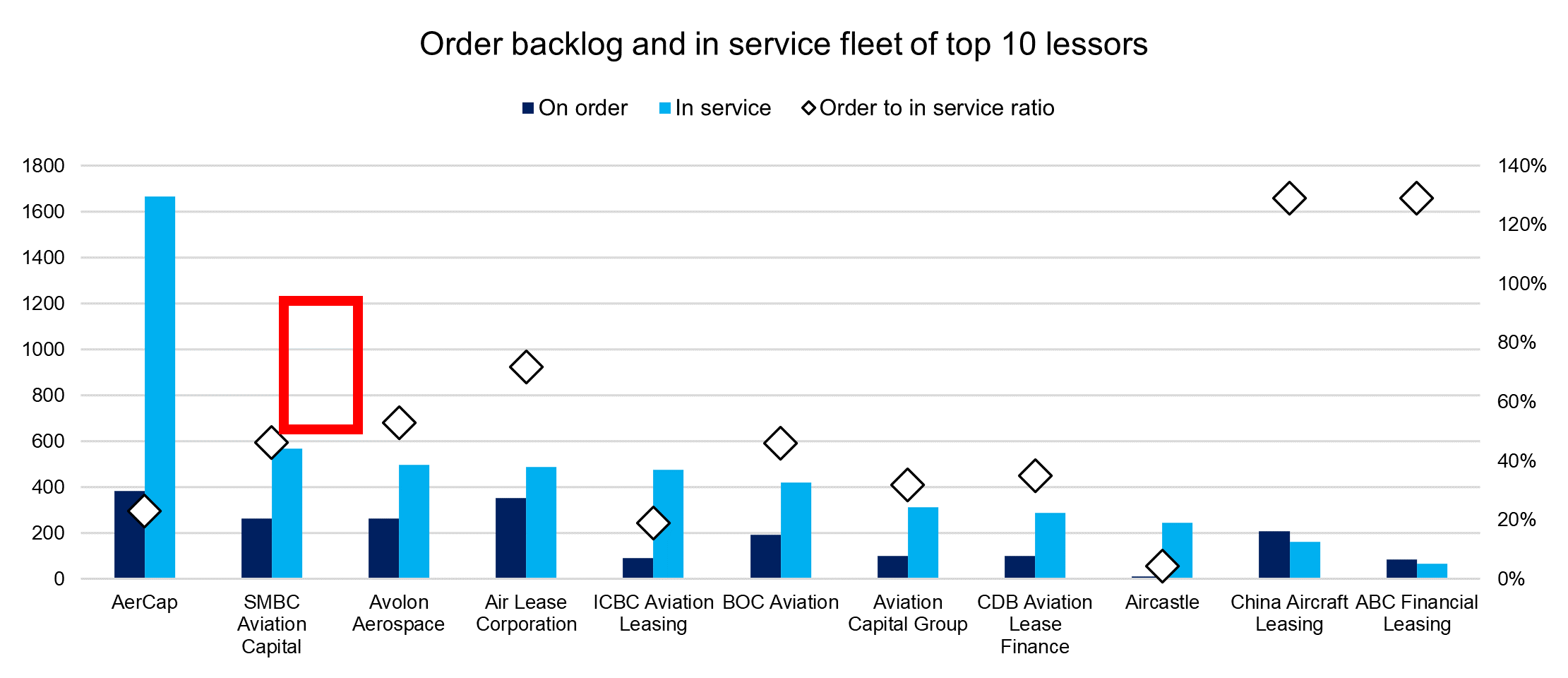
Source: IBA Insight
Our weekly update looks at the key trends and market indicators using data and analytics provided by IBA Insight.

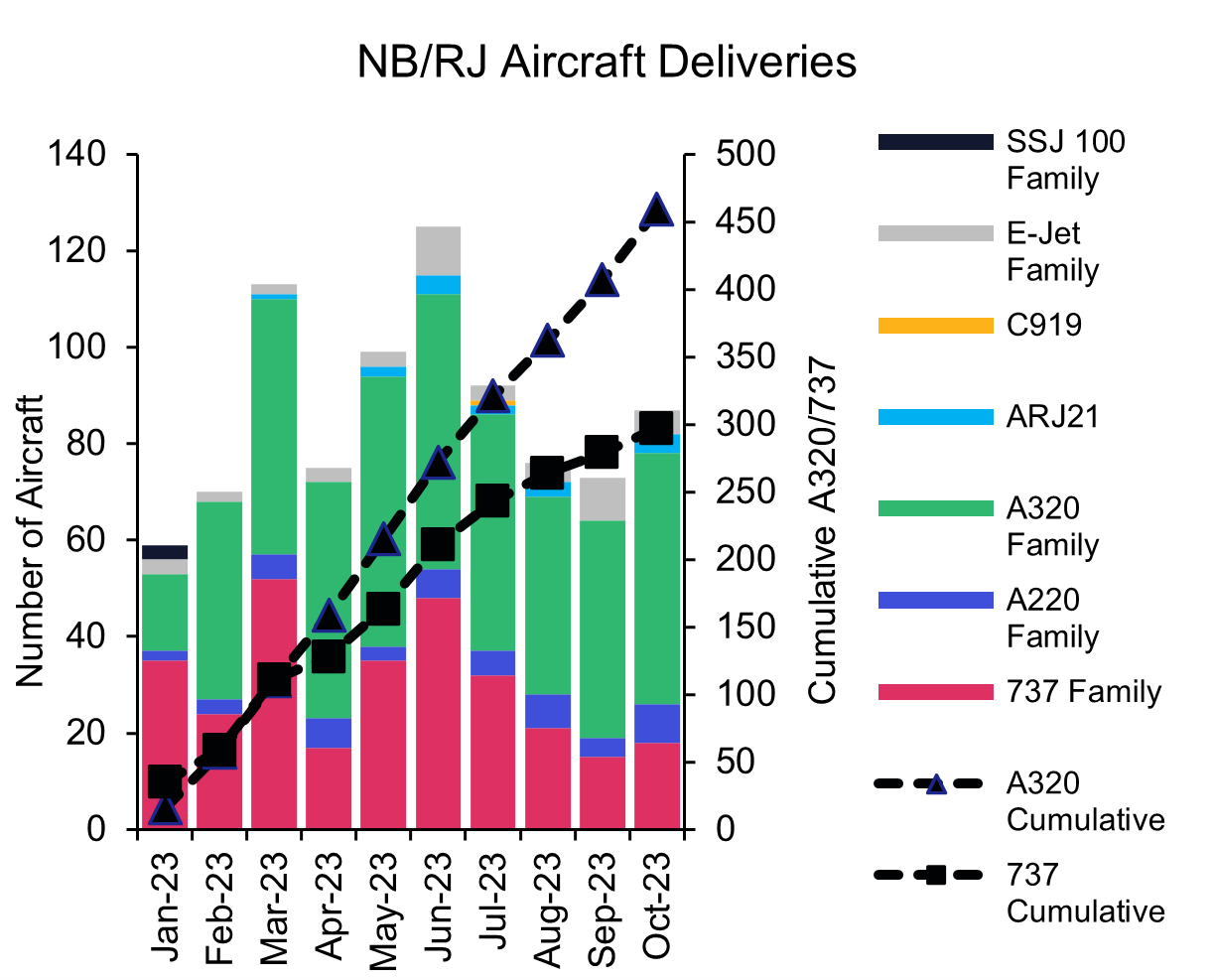
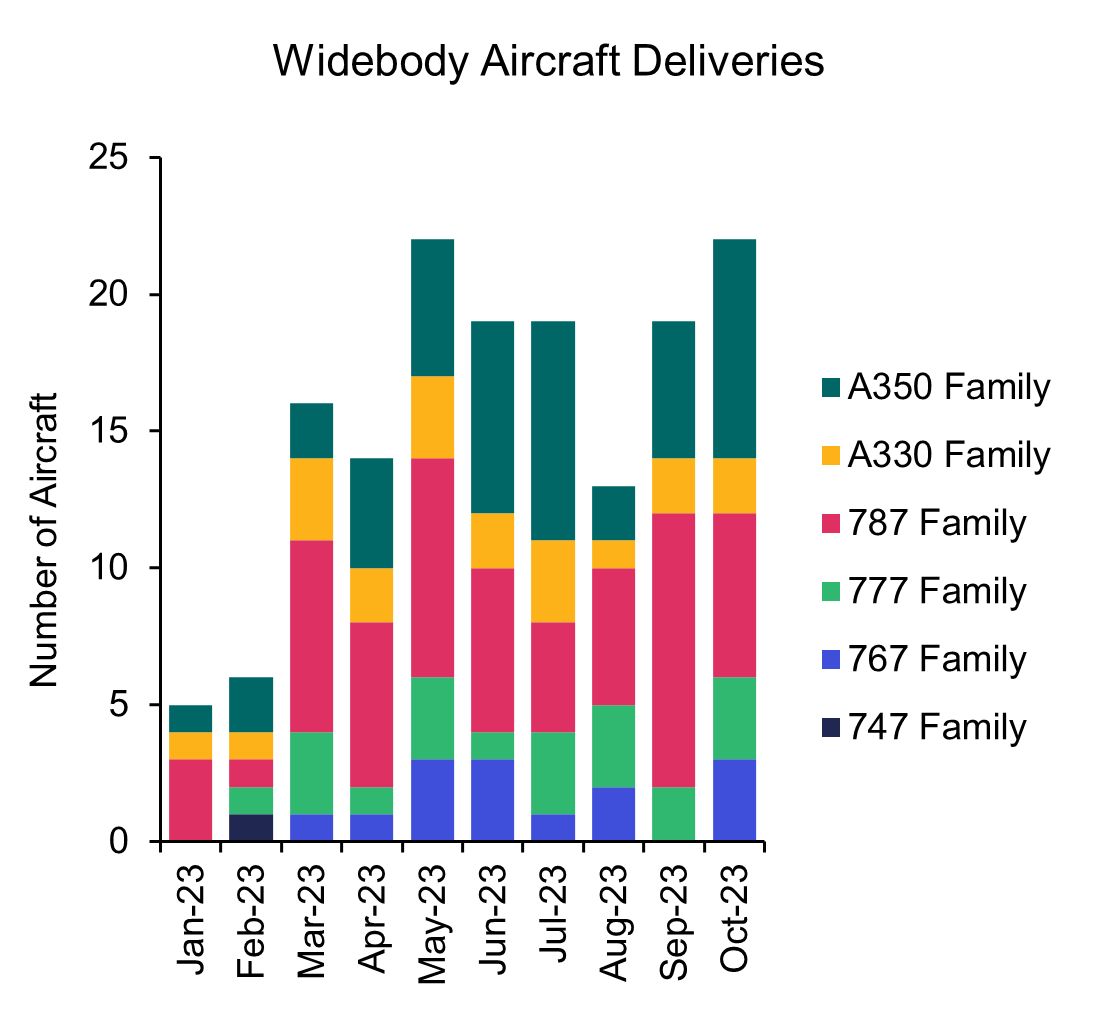


凭借由获奖 ISTAT 认证评估师组成的庞大团队以及 30 多年累积的专有数据,IBA 在全球估值市场上处于领先地位。我们为全球范围内的一系列资产类型提供独立、公正的价值意见和建议,包括飞机、发动机、直升机、货机/航空货运、降落机位和预备件等。IBA 始终致力于超越客户的期望,我们的客观意见为贷款、资产收回、商业开发和再营销提供了必要的安全保障。
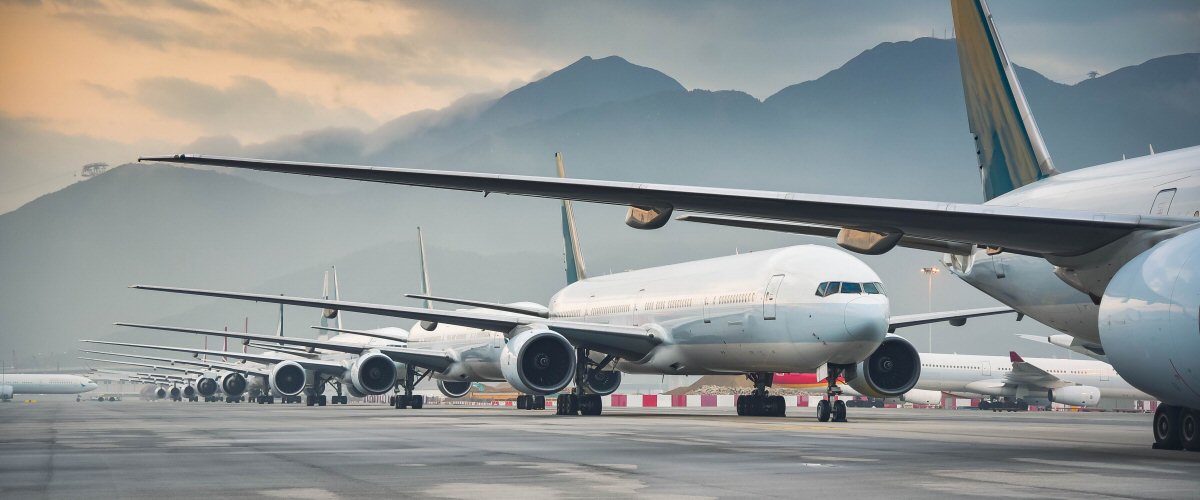
IBA 与全球领先的飞机和发动机租赁公司精诚合作。我们的专业建议植根于深厚的行业知识,因此 IBA 可以在投资周期的各个阶段提供支持,让客户放心无忧。从估值、机队选择、投资组合开发,到租赁结束时的退租和再营销,我们将全程协助客户完成整个租赁期的所有风险评估和资产管理活动。

航空投资往往错综复杂,会涉及大量财务风险,因此,放任资产不去管理绝对是下下策。无论是首次投资的新手,还是市场上驾轻就熟的资深投资者,IBA 都能帮助您克服各种资产类型的复杂性,让您更好地了解各种投资机会。我们可以与您携手合作,支持您的投资组合开发、多元化发展并满足您的战略需求。
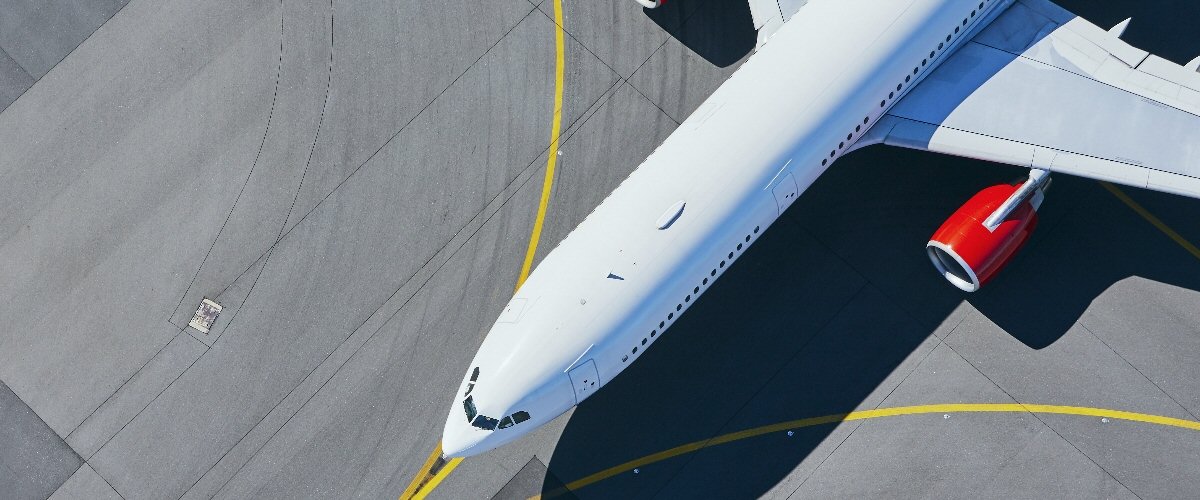
30 多年来,IBA 与全球和地区航空公司紧密合作,提供估值和咨询服务、航空数据情报以及飞机和发动机的退租支持。我们在遍布世界各地的各种航空项目上与客户展开协作,满足他们的额外资源需求,随时随地提供所需的项目管理支持。

我们掌握着丰富资源并善于出谋划策,可为客户提供诉讼支持和纠纷调解办法,并根据客户的法律策略量身定制周密的解决方案。正是由于 30 多年来专有航空数据的积累、定期参与战略并购,以及丰富的飞机管理专业知识,我们能够经常接触到各方之间的典型争端领域。IBA 通过直接或与客户自己的法律团队合作的方式,在各个方面为客户提供帮助,从飞机损坏或损失的保险相关理赔,到常常在退租时发生的租赁商与承租商的纠纷。